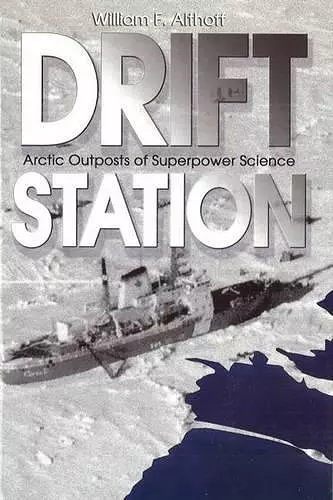Drift Station
Arctic Outposts of Superpower Science
Format:Hardback
Publisher:Potomac Books Inc
Published:1st Jan '07
Currently unavailable, and unfortunately no date known when it will be back

Closed to conventional passage, the Arctic Ocean and peripheral seas have nevertheless known European explorers since the sixteenth century. Systematic observation, however, dates only from the last years of the nineteenth century, with the epic drift of Fridtjof Nansen’s ice ship Fram (1893-1896), the first scientific expedition of the modern era. Twentieth-century technology—the icebreaker, radio transmission, nuclear power, and aircraft—opened the Arctic for survey, basic research, and observation. World War II saw the inhospitable circumpolar Arctic transformed into a theater of military operations.
The Cold War and the missile age saw governments staking further claims, because only a relatively short arc of maritime boreal waste separated North America and Eurasia. The complex interactions of air, ice, and water that drive circumpolar systems also serve as engines of oceanic and atmospheric circulation. As a result, meteorology, oceanography, geophysics, and many other areas of scientific research in the region soon became acutely linked to the economic, political, and particularly the politico-military interests of the Soviet Union, the United States, Canada, and the other Arctic nations.
In response, both superpowers established “drift stations”—that is, isolated camps based on nomadic ice floes—to conduct crucial scientific research. During the Cold War, they were the objects of suspicion, particularly the Soviet stations, which often stood accused as bases for espionage. Today, with the world’s climate system and global warming under study, Russian expertise, data, geography, and stewardship are crucial to the world community.
"William F. Althoff’s work is factual, well-written, and interesting. With the current worldwide interest in global warming and the Arctic’s part in those studies, DRIFT STATION makes valuable contributions to the history of science and research in the Arctic Ocean."—Vice Adm. John H. Nicholson, USN (Ret.)
"Congratulations to William Althoff for his masterful effort in preparing such a detailed account of the activities of ice camps, ships, and submarines helping to gather scientific data on the Polar Basin. Drift Station is the first publication where the scientific activities of the United States, Russia, Canada, and the drift of the Norwegian vessel FRAM have been integrated as a historical overview."—Brig. Gen. Keith R. Greenaway, RCAF (Ret.)
"Imagine a frozen ocean that is an endless expanse of ice and snow. Imagine a place where there are months of darkness followed by a summer without a sunset. DRIFT STATION takes you there, to the floating, drifting pack ice of the Arctic Ocean. It tells the tales of more than one hundred years of scientific research on the sea ice, from the pioneering drift of Nansen’s FRAM to the Cold War outposts of North Pole stations and ice islands to present day efforts to understand climate change. William Althoff escorts us on these voyages to the cold, austere, and beguiling Arctic Ocean and conveys their challenges, rewards, and scientific discoveries."—Dr. Donald K. Perovich, sea-ice geophysicist, Cold Regions Research and Engineering Laboratory
"What historian William F. Althoff calls the ‘White Desert’ emerged as a key arena for superpower rivalry during the Cold War era. A world set apart, the Arctic has drawn over time a succession of explorers, scientists, aviators, mariners, and military figures to its inhospitable terrain. A geologist by profession and a military historian, Althoff is no stranger to the northern latitudes, having made three field trips to Arctic Canada. He masterfully shows how this ‘cruel, vast, faraway’ polar region attracted the United States and the Soviet Union over many decades, a rivalry where the pursuit of strategic military goals mixed awkwardly with ongoing strides in scientific research. Beyond the Cold War, as Althoff notes, the Arctic became the ‘last frontier in oceanography.’ His engaging narrative offers a fascinating blend of history and science, prompting a new appreciation of the Arctic polar region."—Von Hardesty, curator, Smithsonian National Air and Space Museum
"Drift Station is an excellent and unique contribution to arctic literature. A 'well done' to Althoff for undertaking this difficult task and doing it in a way that is very readable."—Naval History
"Polar history enthusiasts will want to add this book to their collections."—ARCTIC
ISBN: 9781574887716
Dimensions: unknown
Weight: 680g
320 pages